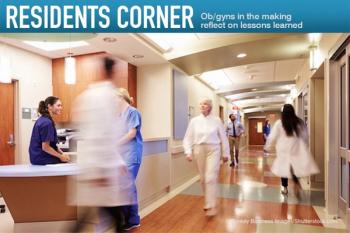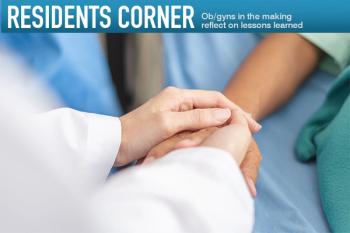
- Vol 64 No 07
- Volume 64
- Issue 07
Building bridges
When a resident’s promise to appreciate nurses is challenged, a conversation with one illustrates how both roles play an integral part in patient care.
There are no doctors in my family, and only a single nurse, my Aunt Frances. When I was accepted to medical school, she took me aside and made me promise to do one thing: Never take the nurses for granted.
I have always found the culturally accepted animosity between doctors and nurses baffling. Medical TV shows would have us believe the two groups are like animals from different species, insisting we are preternaturally destined not to get along, that we come from different worlds.
Frustrated with this concept and determined to heed my aunt’s advice, I committed to do my utmost to buck this trend. At first, it was easy. Throughout my clinical rotations in medical school, I had no trouble befriending nurses and doctors alike; each group was as likely to cheer or chastise me. I hung out at the nurses’ station almost as much as the residents’ workroom. But during my first month as an intern, I noticed something had changed.
A patient came in to the labor and delivery ward at term with decreased fetal movement. Her elevated labs and pressures in triage were consistent with preeclampsia with severe features. Her induction was started but, dulled by a magnesium drip, proceeded slowly. Eventually, though, she dilated to 6 cm and, expecting her to make some change in active labor, I dutifully reported to the nursing station to reexamine the patient. But the nurse was reluctant to accompany me to the patient’s room.
“She’s been up all night, she’s so upset, she feels awful on the magnesium, and it’s only been a couple hours since you last checked. Can’t you just give her a little longer?”
I was confused. The patient’s variability on fetal heart rate (FHR) monitoring was minimal, and she was in active labor. Her category 2 tracing was not dire, but it wasn’t exactly reassuring given her preeclampsia. The
With my aunt’s words echoing in my ears, I pleaded my case as gently as I could to the nurse. She pleaded with me, too, insisting the patient needed rest. Eventually the charge nurse overheard our conversation and told her colleague she had to stick with protocol. As the nurse stood up to join me, she said quietly, “I’m just trying to advocate for my patient.”
I was shocked. Wasn’t I trying to advocate for the patient? And wasn’t she “our” patient? I didn’t want her to have an eclamptic seizure or a stroke, I didn’t want her baby to spend his first 24 hours of life in the neonatal intensive care unit. By the nurse presenting herself as the patient’s advocate, I instantly felt categorized as an antagonist.
We arrived in the room and I did a cervical exam. The patient’s condition remained unchanged. After placement of an intrauterine pressure catheter, and another hour of waiting, the patient was taken to the operating room for a cesarean delivery for arrest of dilation.
I was still upset about the nurse’s words. By accepting the narrative that she and I had different agendas for our patients, she only reestablished the supposedly natural, eternal conflict between doctor and nurse I had been trying so hard to defy.
After that, I grew cynical. I stopped spending time in the nurses’ station and instead retreated as often as I could to the physicians’ workroom. I was cordial and friendly with the nurses, but I didn’t go out of my way to make friends.
And then one day, a different nurse stopped me in the hall of the labor and delivery floor to ask a question about a patient. “I have the patient in room 9,” she said. “Are you taking care of her?”
“Yes, of course,” I said. “I’m taking care of everybody.” She looked confused. How could I be taking care of a dozen laboring patients at once?
This short conversation brought home two conclusions for me. First of all, this nurse and I had fundamentally different definitions of the word “care.” The level of deep, committed, responsive care she was expected to provide was entirely different from the clinical medical care I was offering. I am hardly an automaton and endeavor to spend time getting to know my patients beyond their medical diagnoses. But it would be impossible for me, managing an entire labor floor, to have the same intimate relationship with every patient that the nurse could offer.
Second, I realized that neither of us really understood the other’s job. I thought back to my conversation with the nurse who told me she was advocating for her patient. I had not realized then just how much time she had spent taking care of this patient, one-on-one, and how she had been this patient’s source of comfort and reassurance. How could she not see herself as an advocate and a defender, especially against possibly unnecessary interventions from a doctor who was only able to visit this patient every few hours?
I decided to quit holing myself up with the other physicians. Whenever I had a free moment, or a question about a patient, I resolved to go sit in the nurses’ station and have an actual interaction. I began asking questions about the nurses’ jobs, about the hundreds of varied tasks they were responsible for, things I had always taken for granted. While sitting there, I saw just how often they got up to check on their patients and how closely they monitored the FHR tracings in front of them. Likewise, they saw just how often my pager went off, summoning me to one of the many patients I was taking care of concurrently.
To be honest, expending that level of emotional effort can be exhausting. Unsurprisingly, it turns out that building bridges with colleagues can be as tiring as the work itself. Ultimately, however, I believe it is a valuable practice. By knowing one another as people, by fully understanding not only how alike we can be but just how vastly different-and equally important-our jobs are, we begin to better understand how our roles complement each other.
And that is an important truth: the jobs are vastly different. How else would we both be able to “advocate” for a patient and yet suggest completely different management plans? But that is why doctors and nurses have been a part of the Western model of medicine since the nineteenth century: they both play roles on the spectrum of medical care. One could not function without the other.
In the “animal kingdom” of modern medicine, perhaps we’re not so different after all.
Articles in this issue
over 6 years ago
Ultrasound errors to avoid: How important is the report?over 6 years ago
Considerations when discussing Essure removalover 6 years ago
Is it possible to make OB coding less complicated?over 6 years ago
Reproductive issues in sickle cell diseaseover 6 years ago
Will vacuum delivery go the way of vaginal breech delivery?over 6 years ago
Making chronic pelvic pain a little less painfulover 6 years ago
Which factors predict likelihood of mesh revision?over 6 years ago
Study supports noninvasive testing for Down syndrome in twinsNewsletter
Get the latest clinical updates, case studies, and expert commentary in obstetric and gynecologic care. Sign up now to stay informed.










